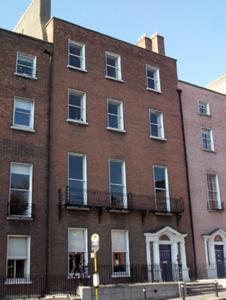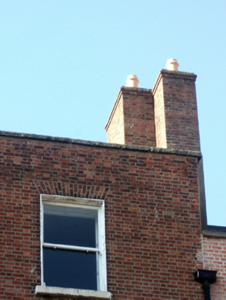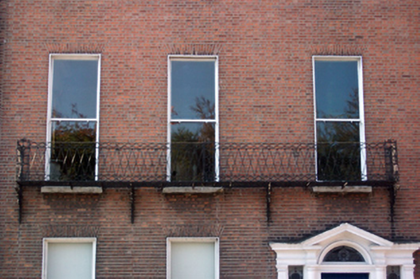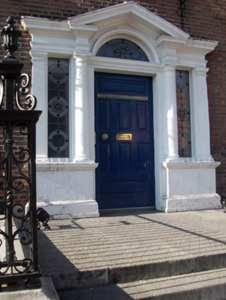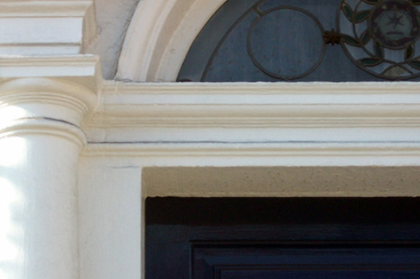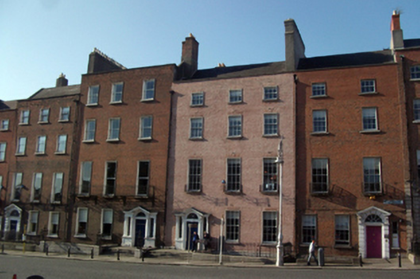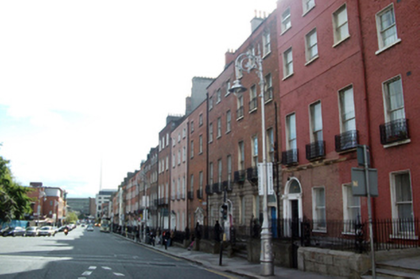Survey Data
Reg No
50010645
Rating
Regional
Categories of Special Interest
Architectural, Artistic
Original Use
House
In Use As
Office
Date
1755 - 1765
Coordinates
315556, 235046
Date Recorded
28/09/2011
Date Updated
--/--/--
Description
Terraced three-bay four-storey house over exposed basement, built c.1760. Now in use as offices. Entrance bay set further from other bays. Roof concealed behind rebuilt parapet wall with squared granite coping. Flemish bond red brick walls with moulded granite plinth course over coursed granite walls to basement level. Top floor rebuilt and raised at later date in red brick. Gauged granite flat-arched window openings with granite sills to basement level. Granite lintels to third floor windows to rear. Gauged red brick flat-arched window openings with rendered reveals and granite sills elsewhere. Replacement one-over-one pane timber sliding sash windows of c.1825 to upper floors, twentieth-century replacements to basement. Historic wrought-iron balcony to first floor. Square-headed door opening within painted stone Tuscan doorcase having engaged columns on plinth blocks with responding pilasters, surmounted by entablature with open-bed pediment, housing replacement stained-glass fanlight. Replacement timber door with brass fittings, with flanking replacement stained-glass sidelights having cast-iron sill guards to plinths. Door opens onto dressed granite platform with two cast-iron bootscrapers and granite stepped approach bridging basement, flanked by wrought-iron railings on replacement granite plinth, with matching gate to platform accessing modern steel staircase to limestone flagged basement level. Backs onto Dominick Place with three-storey pitched roof building.
Appraisal
Located on historic Parnell Square, this finely-proportioned townhouse with its well-balanced façade is an integral component of the streetscape. Built by Robert Ball, along with Nos. 32, 34 and 35, it is now in use as the home of the Irish National School Teachers Association, as are Nos. 34 and 35. The retention of historic features such as the substantial doorcase, long balcony to the first floor, and coursed granite details to the basement help maintain the building's early aspect and contribute to its architectural importance. The sympathetic timber sash windows enhance the character also, and the fenestration is made somewhat unusual by the asymmetrical gaps between the bays. The interior reportedly retains a considerable amount of original fabric, including a double-height stair hall, interconnecting first-floor reception rooms with marble nineteenth-century chimneypieces, lugged door surrounds and modillion cornices. The rear is also said to retain a well and a series of brick-vaulted stores with a granite arcade and Coade stone mask keystones. Parnell Square was the creation of Dr Bartholomew Mosse who, in 1748, leased four acres at the junction of three important sites: the Gardiner Estate, Sackville (now O’Connell) and Great Britain (now Parnell) Streets. There the New Gardens (now the Garden of Remembrance) were constructed, a landscaped tract of land with illuminated paths, obelisks and loggia. Entrance fees to the gardens funded the construction of the Rotunda Hospital to the south, Mosse’s life ambition, and the success of the gardens precipitated the development of the surrounding square, largely by the hospital's chief builders.

